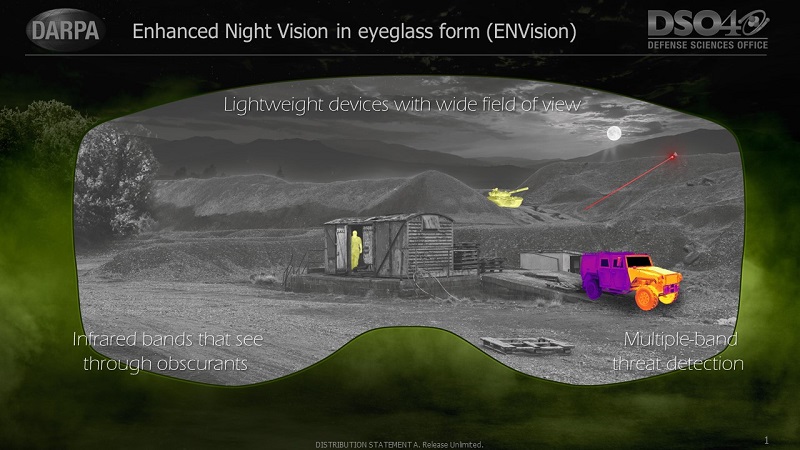| Night-Vision Revolution: Less Weight, Improved Performance
夜视革命:减轻重量,提高性能 Date:2021-01-14 Source:USGovernment By:Globalmil Viewed: |
Leveraging new tech, DARPA aims for night-vision goggles the size and weight of regular eyeglasses
利用新技术,美国国防高级研究计划局旨在提供常规眼镜大小和重量的夜视镜
by USGovernment January 11, 2021
来源:美国政府 2021年1月11日

For decades U.S. warfighters have benefitted from advanced night-vision technology, allowing pilots to fly low-level missions on pitch-black nights and ground forces to conduct operations against adversaries in the dark. But current night-vision goggle (NVG) technology requires cumbersome binocular-like optics mounted on a helmet, offering limited field of view (FOV) and putting unhealthy strain on the wearer’s neck. Building on recent scientific advances in photonics and optical materials pioneered in DARPA’s Defense Sciences Office (DSO), a new effort seeks to develop next-generation NVGs that are as lightweight and compact as a pair of regular eyeglasses or sunglasses.
几十年来,美国作战人员一直受益于先进的夜视技术,飞行员可以在漆黑的夜晚执行低级别任务,地面部队可以在黑暗中对敌人进行作战。但目前的夜视镜(NVG)技术需要在头盔上安装笨重的双目光学系统,提供有限的视野(FOV),给佩戴者的颈部带来不健康的压力。基于美国国防部高级研究计划局(DARPA)国防科学办公室(DSO)率先在光子学和光学材料方面取得的最新科学进展,一项新的努力寻求开发下一代夜视镜(NVG),它们像普通眼镜或太阳镜一样轻巧和紧凑。
DARPA today announced its Enhanced Night Vision in eyeglass form (ENVision) program. ENVision aims to create lightweight NVGs that offer a wide FOV across multiple infrared (IR) spectrum bands without needing separate optics for each IR band. The goal is to enable night vision through fog, dust, and other obscurants as well as provide thermal vision – all via a single flat lens. A Proposers Day for interested participants is being held via webinar on January 21, 2021.
美国国防高级研究计划局(DARPA)今天宣布了它的眼镜形式增强夜视(ENVision)计划。ENVision的目标是创建轻量级夜视镜(NVG),它可以在多个红外(IR)光谱波段提供宽视场,而不需要为每个红外波段提供单独的光学元件。其目标是透过雾、灰尘和其他遮蔽物实现夜视,并提供热视力——所有这些都是通过一个平面透镜实现的。2021年1月21日,通过网络研讨会为感兴趣的参与者举办了一个“提案者日”。
“Our warfighters experience significant neck strain from current NVGs caused by the weight of the optics extending 4-5 inches in front of their helmets,” said Rohith Chandrasekar, program manager in DARPA’s Defense Sciences Office. “If you’ve never worn NVGs for hours at a time imagine wearing a baseball cap all day with a two-pound weight attached to the front of the bill – that gives you a small sense of the stress experienced. Extended use of such systems leads to a condition where the neck no longer has energy to keep the head upright requiring warfighters to use their hands to lift and point their heads. NVG wearers also have to swivel their heads frequently for peripheral vision since current optics only provide a 40-degree field of view compared to the 120-degree wide view we have with our eyes, which only makes use of NVG systems more painful.”
美国国防部高级研究计划局国防科学办公室的项目经理罗希思·钱德拉塞卡(Rohith Chandrasekar)说:“我们的作战人员由于头盔前4-5英寸光学系统的重量,在当前的夜视镜(NVG)中经历了严重的颈部拉伤。”。“如果你从来没有一次戴过几个小时的夜视镜(NVG),想象一下整天戴着一顶棒球帽,帽舌正面贴着一个两磅重的东西——这会让你有一点压力感。这种系统的长期使用导致颈部不再有保持头部直立的能力,这就要求战士用手抬起并指向头部。佩戴夜视镜(NVG)的人还必须经常转头进行周边视觉,因为目前的光学系统只能提供40度的视野,而我们的眼睛能提供120度的广角视野,这只会让使用夜视镜(NVG)系统更加痛苦。”
Besides the weight and field-of-view constraint, current NVGs provide only a narrow segment of the IR portion of the spectrum (typically near-IR) that limits what types of threats the viewer can see at night. Efforts to expand FOV and IR bandwidth to date have involved increasing the number of optics, which increases weight.
除了重量和视野限制外,目前的夜视镜(NVG)只能提供光谱中红外部分的狭窄部分(通常是近红外),限制了观看者在夜间可以看到的威胁类型。迄今为止,扩大视场和红外带宽的努力包括增加光学器件的数量,这增加了重量。
The ENVision program is designed to break the paradigm that increased performance can only be achieved by an increase in weight.
ENVision计划旨在打破只有通过增加重量才能提高性能的模式。
“DARPA investments over the past decade have led to breakthroughs in the areas of planar optics, detection materials, and novel light-matter interactions,” Chandrasekar said. “ENVision will leverage these advancements, amongst others, to develop enhanced night-vision devices in lightweight eyeglass form factors.”
钱德拉塞卡说:“美国国防高级研究计划局在过去十年的投资已经在平面光学、探测材料和新型光-物质相互作用领域取得了突破性进展。”。“除其他外,ENVision将利用这些先进技术,开发具有轻巧眼镜外形的增强型夜视设备。”
ENVision will also investigate the possibility of night vision using direct photon up-conversion from infrared to visible photons using thin materials.
ENVision还将研究利用薄材料将红外光子直接转换为可见光子实现夜视的可能性。
“This will further simplify NVG systems by advancing from the multi-step conversion currently used to a single step up-conversion process,” Chandrasekar said. “Some of these processes even conserve the momentum of photons, which, in theory, could enable night vision without the need for any optics.”
钱德拉塞卡说:“这将进一步简化NVG系统,将目前使用的多步转换过程推进到一步转换过程。”。“其中有些过程甚至可以保持光子的动量,从理论上讲,光子可以实现夜视,而不需要任何光学元件。”
The ENVision program focuses on developing prototypes of multi-band, wide-FOV night vision systems and investigating methods to amplify photon up-conversion processes from any IR band to visible light.
ENVision计划专注于开发多波段,宽视场夜视系统的原型以及研究方法,以放大从任何红外波段到可见光的光子上转换过程。
上一篇:Pakistan conducts successful test flight of Fatah-1 GMLRS 下一篇:DOD’s Autonomous Vessel Sails Through Transit Test, Participates in Exercise Dawn Blitz
| Here are the bunker-buster bombs used on Iran’s Fordo nuclear facility
这是用于伊朗福尔多核设施的碉堡炸弹 |
| In inserting itself into Israel’s war against Iran, the U.S. unleashed its massive “bunker-buster” bombs on Iran’s Fordo fuel enrichment plant.... [2025-07-05] |
| Ukraine's new F-16s receive secret US electronic warfare systems to counter Russi
乌克兰新获的F-16战斗机接收了美国的秘密电子战系统,以应对俄罗斯的威胁 |
| The electronic warfare systems on these Ukrainian F-16s were not part of the U.S. inventory, presenting a significant challenge for the 68th Electronic Warfare Squadron.... [2024-08-28] |
| No U.S. Navy Aircraft Carriers Deployed In The Pacific
美国海军没有在太平洋部署航母 |
| The U.S. Navy is facing a shortfall of deployed carriers in the Pacific as the buildup in the Middle East continues. ... [2024-08-27] |
| France and Serbia Successfully Conclude Negotiations for Sale of 12 Rafale Fighte
法国和塞尔维亚成功完成12架阵风战斗机的销售谈判 |
| Dassault Aviation has successfully concluded negotiations for the sale of 12 Rafale fighter jets to Serbia, marking a significant advancement in bilateral relations between France and Serbia, as reported by LaTribune.... [2024-08-27] |
